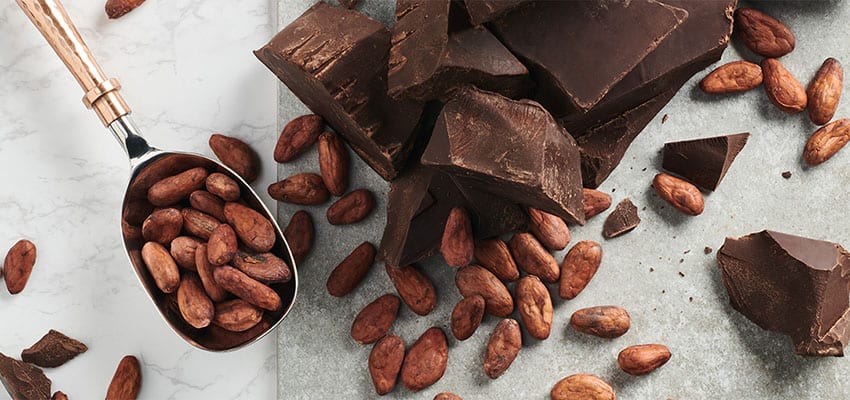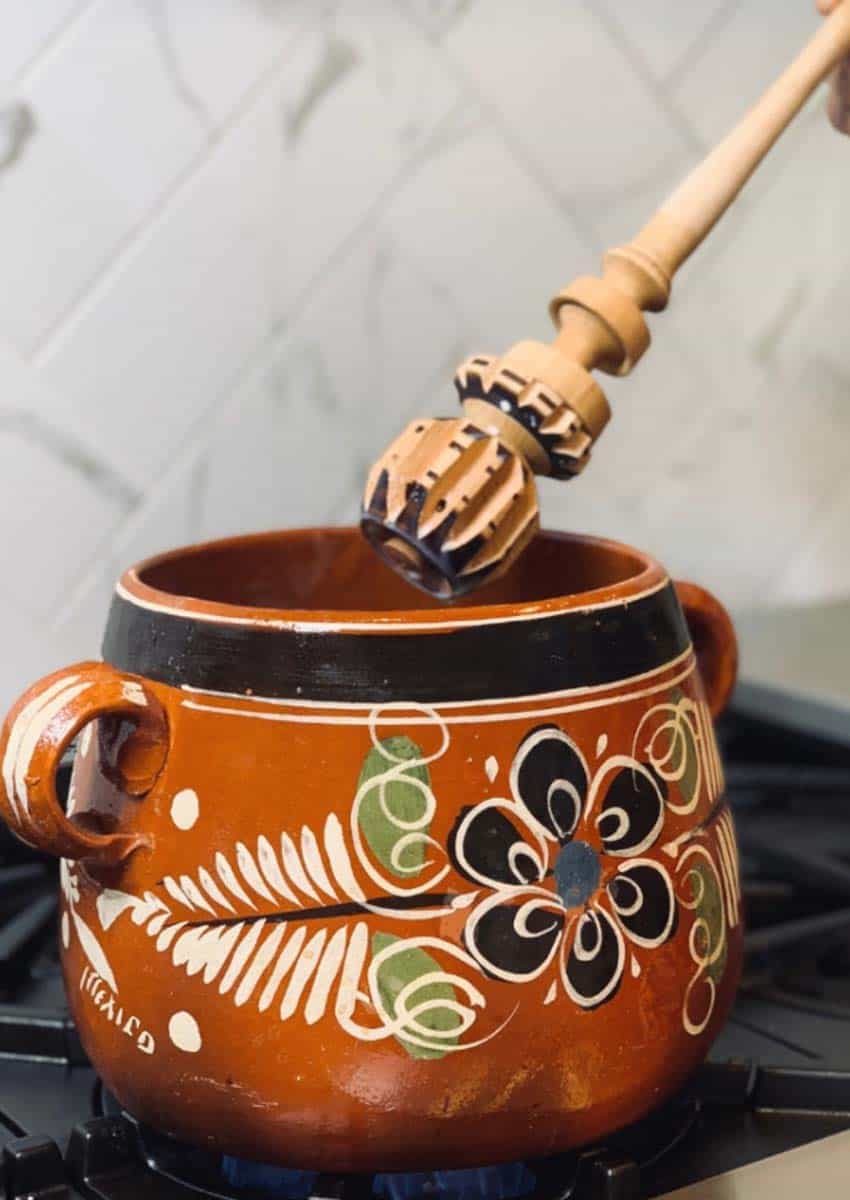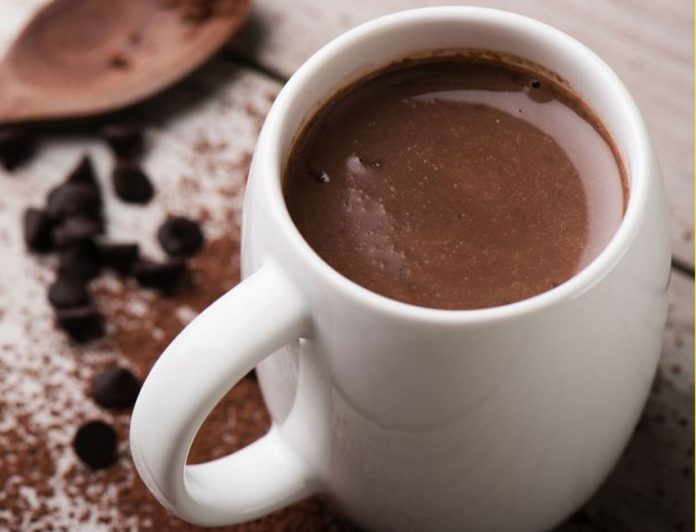Most people know that it was the Mayans who first consumed and used cacao. According to historians, they used cacao beans and paste extensively in ritual as well as for eating and drinking. There were some differences, though.
That ancient version of “hot cocoa,” wasn’t even hot — it was drunk cold — and was more like champurrado with a kick, made from ground cocoa beans, cornmeal, chili peppers and water, poured back and forth between two containers until foamy and thickened.

With the arrival of the conquistadors in the 1500s, that traditional chocolate drink began to evolve to the hot cocoa we know today. Hernán Córtes brought it back to Spain on one of his expeditions, and the bitter but delicious and exotic chocolate drink quickly became an indulgence of the wealthy upper class. (As with most imported foods — still true today! — cacao beans were expensive.) The chocolate-loving Spaniards omitted the chiles, added sweetener and served the drink hot, albeit still made with water.
It would be another 100 years before “hot cocoa” spread to other parts of Europe. In London, where “chocolate houses” became all the rage, milk was substituted for water, creating a richer, more palatable drink. That idea was also imported, this time from Jamaica, where the president of the London Royal College of Physicians had first encountered it.
Moving into the present, hot cocoa — and cocoa powder — runs the gamut between mundane and gourmet, from the American just-add-water packets to the luxurious, thick Italian cioccolata calda. In Mexico, the standard and most common version of a hot chocolate beverage is made from big round tablets of cocoa paste, cinnamon and sugar, sold in distinctive red and yellow boxes, the most popular being the Abuelita and Ibarra brands. (Word to the wise: Don’t be fooled into thinking you can eat the tablets like candy; they’re quite grainy and not very sweet.) These are crushed into a pan of milk, heated and then vigorously whisked to mix, using either a hand whisk or a traditional wood molinillo, which adds an element of fun to the process. If you’re lucky and determined, your efforts may yield the foam that’s a delicious part of this traditional drink.
If you prefer the kind of classic hot cocoa most of us grew up with, the most important factor to consider when making it is, of course, the type of cocoa. Without going into the many varieties of cacao beans (just like coffee, they have different flavors, aroma and qualities depending on where and how they’re grown and processed), the most basic question you’ll find yourself confronted with is whether to choose “Dutch process” or regular/natural cocoa powder.
Are they interchangeable? Yes. But if you do a side-by-side test, you’ll certainly taste and see a difference.
Again, some history: it was the Dutch — with a monopoly on the cocoa trade — who invented cocoa powder and then developed solid chocolate in 1876. Fresh cacao beans are fermented, dried and then roasted (again, much like coffee) and then crushed into tiny pieces called nibs, which are then ground into a paste. Next the surprisingly tasteless cocoa butter is extracted, leaving dry crumbled solids. That’s what’s ground to make “regular” or natural cocoa powder — think Hershey’s, Ghiradelli, Nestle’s — with a sharp, almost fruity flavor.
Dutch-process cocoa powder is rinsed with a solution of potassium carbonate to neutralize its acidity a little, giving it a smoother, more earthy flavor. Dutch-process cocoa powders are also darker than their natural counterparts; a good example of a really strong Dutch-process taste would be the almost black, distinctly flavored Oreo cookies.
For making hot chocolate, I’ve found that a combination of Dutch-process cocoa powder (which I bring from the U.S.) and crumbled dark chocolate yields the richest, most decadent flavor. Baking chocolate or a dark chocolate bar will work; chips won’t, though, as they have stabilizers added to prevent melting. Adding a little cornstarch thickens the drink and gives it an almost indefinable luxurious mouthfeel.

Rich Hot Cocoa Mix
- 2 (4-oz) bars baking chocolate or equivalent dark chocolate
- 1 cup Dutch-process cocoa powder
- 1 cup sugar
- 2 Tbsp. cornstarch
- ½ tsp. salt
Freeze chocolate until completely frozen, about 10 minutes; remove from freezer, break into pieces. Process in food processor with cocoa powder, sugar, cornstarch and salt until completely powdered. Transfer to airtight container; store in cool, dark place for up to 3 months.
To make hot chocolate, combine 1–2 Tbsp. mixture with 1 cup boiling milk, stirring or whisking to mix. To thicken further, return to heat and simmer 30 seconds until thick and smooth, stirring constantly.
Spicy-Sweet Mezcal Hot Chocolate
- ¼ cup cocoa powder
- 1 Tbsp. sugar
- Salt
- 2 cups milk
- 6 cinnamon sticks
- 1 whole dried ancho chili pod, split
- 8 oz. crumbled dark chocolate bar
- 5 oz. mezcal
- Toppings: chile powder, dark chocolate shavings
Mix cocoa with sugar and salt in saucepan. Stir in milk, two cinnamon sticks, chile and crumbled chocolate. Heat over medium heat, stirring, until chocolate melts. Gently whisk to completely mix. Simmer over low, whisking occasionally, until fragrant, about 10 minutes.
Strain, discarding chile and cinnamon sticks. Return milk mixture to pot, add mezcal, and heat. Using a milk frother, whisk or molinillo, mix until foamy. Serve, garnished with chile powder or chocolate shavings and a cinnamon stick.
Makes 4 servings.
Barbajada Hot Chocolate
- ¼ cup cocoa powder
- ¼ cup sugar
- ½ cups milk
- 2/3 cup strong coffee or espresso
- Whipped cream, for serving
In medium bowl, mix cocoa powder and sugar. Heat milk over moderate heat; whisk in cocoa/sugar mixture and coffee, whisking rapidly until frothy. Ladle into mugs and top with whipped cream.
Janet Blaser is the author of the best-selling book, Why We Left: An Anthology of American Women Expats, featured on CNBC and MarketWatch. She has lived in Mexico since 2006. You can find her on Facebook.
